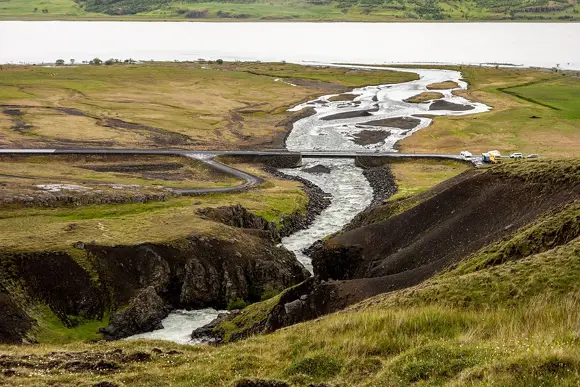Fascinating Myths in Iceland

A Comprehensive Guide to Icelandic Folklore & Legends
In a realm where fiery volcanoes clash with icy glaciers and the Northern Lights illuminate the winter sky, Iceland is a place where the boundaries between the natural and the supernatural blur. This remote island, forged by the raw power of nature, is steeped in legends that echo with the whispers of ancient gods, elusive elves, and fearsome trolls. Here, the winds carry folktales of hidden worlds beneath the earth, where creatures of myths and legend dwell. Join us as we delve into the mystical narratives at the heart of this Nordic land.
Lagarfljótsormur, the Icelandic Loch Ness monster
Deep in the waters of Lake Lagarfljot in East Iceland lies the beast, Lagarfljótsormur (the Lagarfljot worm), similar to Scotland’s Loch Ness monster. Legend has it that a young girl once asked her mother how to make the most of the gold ring she gave her. The mother told the daughter a myth, according to which, gold can grow on a worm. So the young girl trapped a worm alongside her gold ring in a chest. But alas, it was the worm that grew bigger instead. Scared, she threw the chest into the lake making it the monster’s home for eternity.
The legend stems from the eerie atmosphere around the lake. Of late, its existence has been alluded to on the Internet through videos showing a moving form in Lake Lagarfljot.
The Trolls of Vík
The rocky mountains of the Icelandic Highlands are home to big, stupid, and greedy trolls - a prominent character in Icelandic folklore. Although not physically appealing, trolls can perform extraordinary magical feats (including fearsome spells and enchantments). As they aren’t the most clever beings humans can easily free themselves of their enchantments. That being said, trolls have a taste for flesh and often lure unsuspecting humans (including misbehaving children) into their caves through spells, potions, or simply by capturing them.
The Reynisdrangar cliffs, three towering rocks off the beach of Reynisfjara, Vík í Mýrdal, are a testament to the Icelandic legend of trolls turning to stone in the sun.

The Álfhól Dollhouses
No matter where you find yourself in Iceland—whether amidst the bustle of a lively town or deep within the enchanting embrace of its otherworldly landscapes—you are likely to encounter Álfhól. These miniature wooden dwellings, lovingly crafted by human hands, stand as humble abodes for the elves who are believed to inhabit them. Álfhól dollhouses can range from the simplest to the most elaborate and include minute churches, created to convert the elves to Christianity.
Huldufólk, the Elves of Iceland
North European and Germanic mythology refer to elves as beautiful subtle eternal beings having extraordinary magical power. In Iceland, elves are called Huldufólk (hidden people) as they live in enchanted rocks and cliffs. Their resemblance to humans and their lifestyle is remarkably uncanny and believed to be why they are invisible most of the time, except for occasions like Midsummer Night and New Year’s Eve.
Icelandic elves are fiercely protective of their enchanted homes and are known to unleash great harm on those who disturb them. The latest manifestation of this myth occurred during a road-laying project at the Gálgahraun lava field in 2015. Mysterious breakdowns and strange accidents plagued the project until, at last, the road was rerouted to bypass the hidden people's realm, leaving their secrets undisturbed.
Iceland’s Yule Lads
In Iceland, the holiday season doesn’t start until Yule Lads, or rather the first of these thirteen mischievous creatures have made their appearance. These thirteen brothers, who trace their lineage back to trolls, inhabit the pitch-black caves within the mountains, sharing their home with their ogre parents, Grýla and Leppalúði, and the child-eating Yule Cat. Their tradition of creating mischief in rural communities led them to be called names such as ‘The Door Slammer’ and ‘Candle Stealer’. Today these Yule Lads have taken on a new role as the Icelandic version of Santa Claus.
Discover the fascinating Christmas traditions of Iceland on our previous blog.
The Legend of Dimmuborgir
Around 2,300 years ago an eruption in the Lake Mývatn region of northern Iceland created lava column sculptures at Dimmuborgir. Translated to ‘dark castle’ in English, Dimmuborgir has been described as the gateway to Hell in Nordic legends. Grýla and Leppalúði, the troll parents of the Icelandic Yule Lads are known to kidnap little children and bring them here during Christmas time. The place also has references in pop culture, most notably, the Norwegian dark metal band, Dimmu Borgir.
The lava from the eruption that created Dimmuborgir can also be seen in nearby volcanic areas such as Námaskarð Pass, Grjótagjá cave, and Krafla fissure.

As the mist settles over Iceland's rugged landscapes, the tales of ancient beings, hidden worlds, and timeless magic linger in the air, leaving an indelible mark on the soul. If you’re spurred by the desire to discover the magic that dwells in this ancient land, book a stay at our Icelandic hotels for a comfortable stay during your mystical explorations!